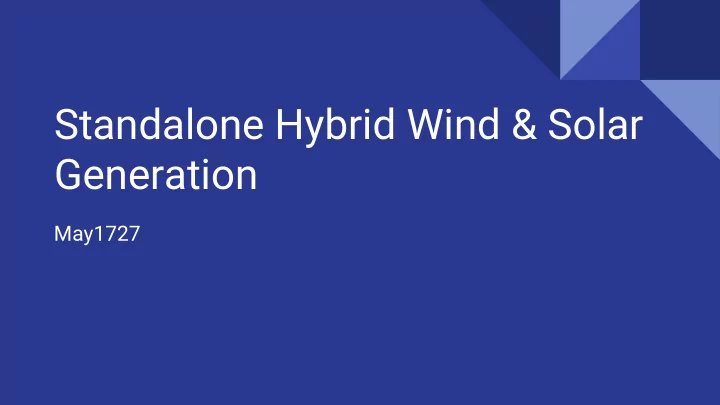

Standalone Hybrid Wind & Solar Generation May1727
Team Members: Faculty: Matt Lee Dr. Ajjarapu Nathaniel Byrne Michael Trischan PhD Graduate Students: Brian Gronseth Ankit Singhal (PhD Candidate) Eric Cole Jeffrey Szostak Pranav Sharma (PhD Candidate)
Project Plan- Project Statement ● Formal Project Statement: “To Create a combined Solar and Wind Electrical generation system that hybridizes the most supporting hardware as possible.” ● Deliverables Design a hybrid wind and solar system ○ ○ Add components to existing PV array Wind Turbine, Inverter, Solar Panels ■ ○ Create labs for EE 452 centered around the hybrid system so future ISU students can use the hybrid system as a learning tool.
Project Plan- Conceptual Sketch
Project Plan- Requirements Functional Requirements ● ○ Working Simulink diagrams for both the wind turbine and PV array. ○ Solar panels will utilize maximum power point tracking control, as well as a boost converter. ○ The wind turbine will produce AC power that is rectified and then sent to a Buck/Boost converter. ○ Both systems meet to charge the battery and from the battery go through the inverter to power the load. ○ Nonfunctional Requirements ● Analysis of solar and wind generation system components ○ ○ Analysis of solar and wind emplacement for max power generation Measure of wind speed and irradiance ■ ○ Create labs for EE 452 centered around the hybrid system so future ISU students can use it as a learning tool.
Project Plan- Constraints/Risks/Considerations ● Lack of experience Power Systems ○ ○ Simulink Non-engineering aspects ● ○ Wind turbine placement regulation ○ Budget ○ ● Risks Lab safety ○ ○ Wind Turbine setup
Project Plan- Market and Costs ● Market Survey ○ The customers for this project are future EE 452 students, as well as the EE power department. An important component of this project is the relationship with WESO, who is willing to allow ○ academic use of their wind turbine for certain periods of the semester. ■ Saves money Non-black box model ■ ● Resource/Cost Estimate ○ Solar Panels
Project Plan- Milestones and Schedule ● Researched wind and solar systems Boost converters, MPPT, inverters, turbine prices ○ ● Obtained wind turbine from WESO ○ Planned with Coover administration about ○ turbine placement ● Wind and solar teams design respective systems in Simulink ○ Parameters are modeled after the existing PV hardware and potential wind hardware. Simulink models functioning individually. ○
Wind System Flowchart o
Wind Generator
Generator Output 12 m/s 10 m/s 8 m/s 5 m/s
AC-DC-AC
AC-DC-AC Output
Solar System Flowchart
Solar System
Solar PV
Solar System
MPPT
P&O Algorithm
Solar System
Buck
Solar System
Battery
Solar System
Inverter/Load
Hardware Technology Platform MPPT Solar Panels Inverter Batteries Load
Instruments User Adjustable Load Data Recorder Monitor Safety Switch Functional Prototype planned to be implemented next semester. Voltage, Current, and Power Meters
Conclusion- Status Current Project Status Software: ● Section-by-section functionality Simulink models for the Wind and Solar systems. Hardware Obtained permission from WESO to use their Wind Turbine. ● The turbine is fully functioning and generates either 3-phase ● AC voltage or DC voltage. It’s equipped with several sensors which can be used in lab.
Conclusion- Contributions Individual Contributions: Eric Cole - Webmaster - Developed Team Website and Wind Simulink Model Jeffrey Szostak - Wind Tech Lead - Procured WESO Wind Turbine Usage Michael Trischan - Key Concept Holder - Researched Potential Wind Turbines Nathaniel Byrne - Group Leader - Solar Fundamentals and Solar Panel Research Matt Lee - Communications Leader - Communications, Weekly Reports, Solar Simulink Model Brian Gronseth - Solar Tech Lead - Solar System design, hardware setup
Conclusion- Plan Next Semester Plan: Combine solar and wind simulink diagrams with batteries ● Combine hardware systems ● ○ Purchase additional Solar Panels Make necessary edits to WESO wind turbine ○ ● Create lab documents for EE 452
Conclusion- Questions Questions? Contact info: Email: may1727@iastate.edu Website: http://may1727.sd.ece.iastate.edu
Appendix
ALEKO 350 W VAWT Rated Power 350 W Start up speed 1.5 m/s Rated speed 11 m/s Max speed 45 m/s Diameter 1.12 m Cost $495.00 Shipping Free; 1-3 weeks http://www.alekoproducts.com/ALEKO-350W- 24V-Vertical-Wind-Power-Generator-p/wgvq3 50w24v-ap.htm
Max Power 650 W Shineman 600 W VAWT Rated Power 600 W Start up speed 3 m/s Max speed 40 m/s Diameter 1.2 m Height of tower 6 m Cost $480.00 Shipping Free; 5-7 weeks http://www.ebay.com/itm/1m-length-600W-Win d-turbine-Vertical-axis-blade-high-quality-for-sa le-5pcs-lot/262679596613?_trksid=p2047675.c 100005.m1851&_trkparms=aid%3D222007%2 6algo%3DSIC.MBE%26ao%3D1%26asc%3D3 9497%26meid%3De8946d39f4aa4d07808671 ea391cf64c%26pid%3D100005%26rk%3D2% 26rkt%3D6%26sd%3D252581684544
Typical power curve for turbines we researched
Wind Turbine
Wind Turbine and Generator
Generator Output
Three phase Rectifier Sqrt(3)*Vpeak
Rectifier Output
Boost Converter Duty Cycle = 1-(Vin/Vout)
Boost Converter Output
Inverter
Inverter and Transformer Output
AC-DC-AC
AC-DC-AC Output
Forecasted Prototype Functional Prototype planned to be implemented next semester. Along with aforementioned Design, Prototype will have: ● Meters for measuring current and voltage values, similar to simulations. Monitor and Controller for analysing data during operation. ● User Interface limited to adjusting load via light bulb switches, as seen on ● previous slide.
Recommend
More recommend